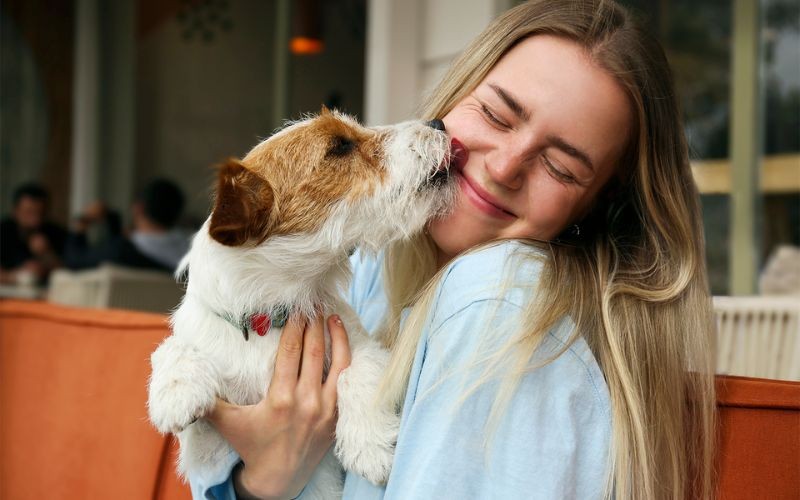
Decoding Dog Behavior: Why Dogs Lick Your Face
In the intricate dance of canine communication, every lick, nuzzle, and tail wag carries a nuanced message. So, why do dogs lick your face? In the delightful world of dog parenting and companionship, there's perhaps no gesture more endearing than the slobbery, affectionate “kiss” from one of our furry friends. But what prompts dogs to engage in this adorable behavior? Beyond the surface-level display of love, there's a wealth of intriguing science behind why dogs are drawn to licking our faces. Read on to uncover the deeper motivations behind this canine gesture!At the heart of the behavior
The act of licking dogs can be traced back to their evolutionary heritage. The mother's lick is the first form of communication puppies experience. This tender gesture serves multiple purposes, from hygiene to emotional bonding. Through gentle licks, a mother stimulates circulation, encourages elimination, and provides comfort and reassurance to her offspring.
As puppies grow, licking becomes a fundamental aspect of their social interactions within the litter. It serves as a means of communication, allowing them to express needs and desires to their siblings and mother. As they transition to adulthood, licking remains a prevalent form of communication.
Communication and bonding
At the heart of a dog's licking behavior lies a primal instinct for social connection. Dogs are pack animals and licking serves as a powerful means of reinforcing social ties within their pack. When your canine companion licks your face, it's their way of saying, "You're an integral part of my pack, and I value our connection.
Taste sensations and exploration
The human skin, to a dog's discerning palate, offers an assortment of tantalizing tastes. From the subtle tang of sweat to the savory allure of salt, our skin provides a sensory playground for our four-legged friends.
Licking also serves as a form of sensory exploration for dogs, allowing them to gather information about their environment and the individuals within it. When your dog licks your face, they're not only enjoying the taste but also learning about your unique scent, facial expressions, and emotional state, deepening their understanding of their human companion.
Affectionate gestures and attention-seeking
For dogs, licking is not merely a sensory experience but a heartfelt display of affection and a bid for attention. When your furry companion showers you with tongue baths, they're seeking not only physical closeness but also emotional connection and positive reinforcement from their beloved human. Your response to their affectionate gestures further strengthens the bond between you and your dog, creating a reciprocal cycle of love and attention.
Instinctual grooming behaviors
The early exposure to maternal grooming instills in them a lifelong association between licking and care. As adult dogs, they extend this nurturing behavior to their human companions, viewing them as cherished members of their social circle worthy of tender grooming rituals.
Stress relief and emotional support
In moments of stress or anxiety, dogs turn to comforting behaviors to soothe their frazzled nerves. Licking serves as a self-soothing mechanism, providing dogs with a sense of calm and security amidst turbulent emotions. When your dog licks your face during thunderstorms or other stressful situations, they're seeking solace and reassurance from the familiar scent and presence of their trusted human.
Learning through human interaction
Dogs are keen observers of human behavior, and they possess a remarkable ability to learn and adapt based on our responses. If your dog receives positive reinforcement, such as affectionate gestures or playful interactions, in response to licking your face, they're likely to continue this behavior as a way of eliciting similar responses in the future.
Imitation of human affection
Dogs are masters of mimicry, often emulating the behaviors they observe in their human caregivers. If they witness you engaging in affectionate gestures such as kissing or nuzzling, they may interpret licking as a similar expression of love and closeness, eagerly reciprocating the affection they've observed.
Creating space
In the intricate dynamics of canine communication, dogs sometimes lick to create space, signaling discomfort or a desire for autonomy. When accompanied by specific body language cues such as moving their head forward, dilated pupils, or a tucked tail, licking serves as a subtle yet significant gesture of defense or boundary-setting. Dogs may use this behavior in response to unfamiliar or overwhelming situations, signaling to others to respect their personal space. As responsible pet guardians, it's crucial to recognize and honor these communication cues, responding with empathy and understanding to ensure our furry companions feel safe and respected in their interactions. Understanding the silent language of licks enhances our connection with our dogs and fosters mutual respect within our relationships.
Conclusion
In the world of doggie communication, every lick, nuzzle, and tail wag tells a story. From expressing affection and seeking attention to signaling discomfort and asserting boundaries, dogs employ a diverse array of behaviors to navigate their world and communicate with their human counterparts. So, the next time your dog showers you with slobbery “kisses”, remember that there's more to it than meets the eye!

